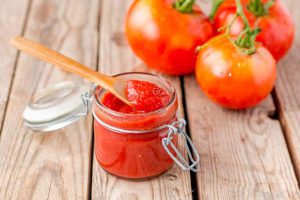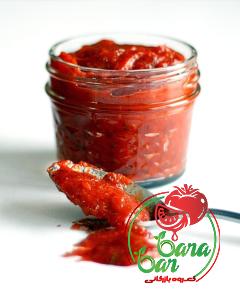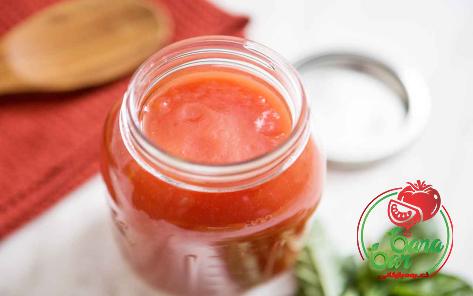Here’s everything you need to understand about tomato paste, including if you should purchase it in a tube and how to use it. Tomato paste is a cupboard must-have for mixing up delectable, deeply flavored dishes; it can elevate a mundane recipe, such as a soup or sauce, to something truly spectacular.
However, because a little makes a big difference, tomato paste is usually found in tiny 6-ounce cans. Though if you buy the smallest can of tomato paste, you’ll still have a lot left over because most recipes just call for a tablespoon or two.
First and foremost. What exactly is tomato paste? Tomato paste is just tomato sauce that has been condensed. Tomato paste is made by cooking tomatoes until they are soft, straining off the skins and seeds, then continuing to simmer the sauce until it reaches a thick consistency.
A stabilizer, such as citric acid, and salt (there are also no-salt variants), as well as herbs and spices, are commonly included in manufactured tomato pastes. There are additional possibilities for tomato paste that is double-concentrated or triple-concentrated, making it even more strong.

Tomato Paste: Why Do You Need It in Your Pantry?
The advantage of using tomato paste over other canned tomatoes (such as tomato puree, crushed tomatoes, or diced tomatoes) or even fresh tomatoes is that you receive the rich tomato flavor without the excess water, which is ideal for recipes like meatloaf or taco filling.
Tomato paste may be used to offer a burst of flavor to quick 30-minute weeknight meals or to increase flavor over time in slow-cooked recipes. Plan to add your tomato paste early in the cooking process, before adding liquids like water, broth, or other canned tomatoes, to get the most flavor out of it. The tomatoes will be able to caramelize and mature much more this way.
Tomato Paste in a Tube
Yes, it exists, and you must purchase it. Tubed tomato paste is a practical substitute for canned tomato paste since it allows you to use only what you need without having to worry about wasting the remainder of the can.
It’s manufactured in the same manner as canned tomato paste, but it’s packed in a squeezable tube with a screw top that keeps the tomato paste fresher for longer. The majority of tubes are 4.5 ounces and provide 9 tablespoons, which is close to the 6-ounce cans of tomato paste that contain 10 tablespoons.

How to Use Tomato Paste
Most of the time, you just throw some tomato paste in a pot, let it simmer, and call it a day. Wrong! If you utilize tomato paste correctly, it’s one of those simple secrets for adding flavor to your sauces. Tomato paste has a strong taste and adds umami (savoriness) to any meal. It’s produced using fresh tomatoes that have been boiled down, drained to remove the skins and seeds, then puréed and simmered until the water content has been reduced to a concentrated paste.
Tomato paste offers a robust tomato flavor to your food without diluting it. When you add it directly from the can (or tube), though, it doesn’t acquire its full flavor and can even taste metallic and raw, which means it may conflict with other components rather than compliment them.
When you combine tomato paste with a liquid such as broth or water, or with a can of diced or whole tomatoes, it doesn’t have a chance to put its concentrated flavor to work. Mixing the stiff mixture into a saucepan full of liquid components might also be tricky.
Here’s how to utilize tomato paste appropriately in any recipe. This kitchen hack allows you to improve recipes by following culinary concepts such as sautéing aromatics (garlic and onions) first or deglazing the pan to scrape out all the delicious, cooked-on morsels from the bottom. What’s the secret? To caramelize tomato paste and achieve its full taste, it must be “cooked.”
It’s ideal if you add it to the pan after you’ve cooked your aromatics, together with your herbs and spices. So, if your recipe calls for sautéing an onion in olive oil for five minutes before adding dried oregano and garlic, you should add your tomato paste at this point.
On medium heat, it just takes a few minutes to deepen in color and unleash its taste. (If you add tomato paste simultaneously time as the onions, it will burn and the onions will not have a chance to soften and brown). Mix the tomato paste with all the other ingredients in the pan or pot, such as onions and carrots, after adding it.
This will make it simpler to spread the tomato paste out and cook it evenly. To keep it from burning, stir it frequently. The color of your tomato paste will shift from vibrant red to dark brick red or brown. Brown shades are excellent; black is not.
Add your liquids after the tomato paste is black and aromatic, and scrape the bottom of the pan to release the concentrated tomato deliciousness into your dish. This will also keep your dish from burning in the future. That’s all there is to it! Carry on as normal with your recipe.

What to Do With Excess Tomato Paste
Oh, and you’re not alone if you’re constantly left with excess tomato paste after preparing homemade pizza sauce or a stew. We’ve never come across a dish that uses the entire six-ounce can. To prevent wasting your extra tomato paste, you have two alternatives. To begin, spoon one-tablespoon amounts of tomato paste onto parchment paper and freeze.
Transfer to a freezer bag once firm. Alternatively, buy a tube of tomato paste. Tomato paste tubes may be kept in the fridge for months. You may squeeze out only what you need and replace the lid, much like a toothpaste tube. Genius! Pesto tubes, anchovy paste, and sun-dried tomato paste are all available. Also, if you have an abundance of fresh tomatoes, you can always create your own.

What does tomato paste do
Tomato paste is made by cooking tomatoes for an extended period of time, extracting as much water as possible as well as the seeds and peel. It’s simply a highly concentrated tomato. Yes, tomato paste that has been double-concentrated is much more concentrated.
This is advantageous since a smaller amount of paste may impart the same taste as a greater quantity of chopped canned tomatoes. It’s especially useful when fresh tomatoes aren’t in season, unavailable, or take up too much room for some reason. As a result, it’s a versatile tomato-based component for a variety of tomato-based dishes.
First, caramelize it
When you’re using tomato paste in your foods, It’s a good practice to sauté tomato paste in oil or another sort of fat for 30 seconds to a couple of minutes, stirring regularly to avoid sticking and burning, regardless of what you’re creating with it.
The tinny I-came-from-a-can-or-tube flavor is gone with that one small step. You may caramelize the sugars and increase the tastes even more by cooking the paste until it caramelizes, turning from a bright red to a darker, browner brick red. A decent rule of thumb is to add your tomato paste when you’re almost done sautéing the aromatics for a meal.
Add depth to pasta sauce
Tomato paste is useful to have on hand when preparing a tomato-based pasta sauce since it may enhance the already existent umami tomato characteristics. It’s an important component of this easy marinara sauce, which is made entirely from canned tomatoes. This salty, strong puttanesca sauce, it’s also essential.
You can prepare this easy, tasty pasta sauce using tomato paste, garlic, and olive oil even if you don’t have any additional canned tomato products on hand. If fresh herbs aren’t available, substitute dried herbs or leave them out entirely.

Make basic beans extra delicious
We consume large amounts of dry beans in our diets, and one of the best ways to prepare them always involves tomato paste. you half or cut an onion, crush a few garlic cloves, and sauté them in a Dutch oven with a glug of olive oil until they start to brown.
Then caramelize the paste with a dollop or two of tomato paste and whatever spices you are feeling that day — generally a mix of smoked paprika, chili flakes, and oregano, or a pinch of cocoa powder — before adding the beans and stock or water. It adds a fantastic depth of flavor to the bean broth.
Boost your braises and soups
Similarly, adding tomato paste before the meat and whatever liquid you’re braising it in may help keep the sauce together and blend the fat, aromatics, and spices you’re using. This is true of all types of meat cuts, from brisket to beef. A spoonful adds umami and richness to almost any soup, but particularly the delectable bean-based soups.
Deploy as a substitute for fresh tomato in Indian curry
Tomato is used in a variety of Indian and Indian-American recipes, and tomato paste can be used as a replacement in a pinch. Nik Sharma, a cookbook wiz, prefers it and utilizes it to produce a strong tomato flavor without boiling down fresh or tinned tomatoes in his incredibly tasty and quick pressure cooker Dal Makhani, for example.
With tomato paste, onions, garlic, ginger, and Madras curry powder or garam masala, you can make a curry-like dish at home, such as Coconut Curry Tomato Sauce or this fast Chicken Curry with Tomato Yogurt Sauce. Alternatively, create a Basic Indian Tomato Curry with any veggies and meat you have on hand.

Use it to make Creole food
Do you want to create étoufée? That’s when tomato paste comes in handy! This Eggplant Dirty Rice is similar, consisting of rice cooked with aromatics such as onions and garlic, as well as tomato paste, spices, and eggplant. The classic meal is cooked with ground pork and chopped chicken liver, but there’s no reason you can’t go with whichever meat you have on hand.
In addition, tomato paste is excellent for enhancing other tomato tastes in any dish. Put a dollop in a canned sauce and heat it down, or use it in a poultry marinade or spice paste. Adding a little tomato paste to anything that might use some flavorful richness would almost certainly help it.

Use up tomato paste
A few Great Ways To Use Up a Can of Tomato Paste
Add it to stews for a boost of umami flavor.
“Tomato paste adds a lot of flavor to a meal and almost makes it umami. If your food is missing something, try adding tomato paste! “Rachel Lessenden, the founder and recipe developer of Health My Lifestyle, says Lessenden says that there are a number of meals that benefit from the flavor of tomato paste “I like to use it in stews. It thickens the sauce and adds wonderful taste depth!”
Stir a spoonful of tomato paste into store-bought marinara sauce.
Jarred marinara sauce lacks the richness of the handmade marinara sauce. “I add tomato paste to store-bought marinara sauce to amp up the taste profile,” says chef and dietitian Cindy Chou of Healthy Feels, if you’re in a time rush and need to utilize store-bought marinara.
Use it to make homemade BBQ sauce.
“Making homemade barbecue sauce is a great way to get creative with tomato paste. To prepare the base, all you need is a can of tomato sauce and tomato paste, and then you may add spices, sweeteners, vinegar, and even fruit. The method is simple, and the finished result is far superior to anything you might buy in a shop “Burrata & Bubbles recipe creator Amanda McGrory-Dixon says.

Tomato paste works beautifully in Korean dishes.
“When I make Korean foods, I prefer to use tomato paste. “Tomato paste is seldom used in Korean cuisine, if at all, so adding it provides a really nice and surprising flavor and texture,” explains Andrew Lim, executive chef at PERILLA in Chicago. Lim uses tomato paste, in particular, to prepare “a Korean meal called dahk-tori-tahng, which is a spicy braised chicken with roasted potatoes, carrots, onions, and any root vegetables you choose.”
It’s a spicy, flavorful, and sweet meal in the traditional sense. To begin, I sear the chicken skin side down to provide texture and render off as much fat as possible. I like to make a sofrito out of tomato paste and Korean chili paste (gochujang, soy sauce, minced garlic, chopped ginger, Korean chili flakes, salt, and sugar) and add it to the vegetables while they’re roasting. This gives the veggies flavor and the broth/sauce a rich, velvety texture.”
Dehydrated tomato paste makes a delicious tomato powder.
Dehydrate the paste in a low-heated oven until all the water has evaporated, then grind into a powder. As a spice, use this tomato powder. Tomatoes with tomato powder as a seasoning? It’s delectable and flavorful.
Use in place of tomato sauce or crushed tomatoes in a ragù.
Follow this suggestion from Italia Like Locals chef/founder Andrea Belfiore to add tomato flavor to a meat sauce without losing its richness or texture “Use tomato paste instead of tomatoes or tomato sauce in a typical Bolognese ragù!
It adds a wonderful blast of tomato flavor without diluting your sauce. Ragù must have a strong, meaty flavor and a thick consistency. If you want to make a ‘rule,’ add some tomato paste to every tomato-based food. It will only heighten the flavor and color, making it richer.”










Your comment submitted.